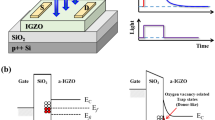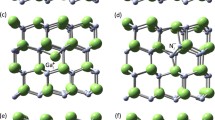Abstract
We have studied the defect formation energies of the various native (vacancies, interstitials, and antisites) and Au defects in Hg1−xCdxTe using density functional-based total energy calculations with ultrasoft pseudo-potentials. These studies are important for infrared (IR) detection technology where the device performance can be severely degraded because of defects. To calculate formation energies, we modeled the neutral and charged defects using supercells containing 64 atoms. From the formation energies, we have determined the defect concentrations as a function of stoichiometry and temperature. We find the prevalent neutral defects to be Au at the Hg site (AuHg ), Hg vacancies (VHg ), and Te antisites (TeHg ). We have also explicitly studied charged defects and have found Te 2+Hg , Au 1−Hg , V 1−Hg , V 2−Hg , and V 2+Te to have low formation energies. We have identified AuHg to be the prevalent Au defect, having concentrations several orders of magnitude greater than the other Au defects. We find that the charge state of VHg is primarily (1−) or (2−) depending on the electronic chemical potential.
Similar content being viewed by others
References
M.A. Berding, M. van Schilfgaarde, and A. Sher, Phys. Rev. B 50, 1519 (1994).
H.F. Schaake, J. Electron. Mater. 30, 789 (2001).
H.F. Schaake, private communication, (2003).
H.R. Vydyanath, J.C. Donovan, and D. Nelson, J. Electrochem. Soc. 128, 2625 (1981).
D.E. Cooper and W.A. Harrison, J. Vac. Sci. Technol. A 8, 112 (1990).
G. Kresse and J. Hafner, Phys. Rev. B 47, RC558 (1993); G. Kresse (Ph.D. thesis, Technische Universitat Wien, 1993); G. Kresse and J. Furthmuller, Comput. Mater. Sci. 6, 15 (1996); G. Kresse and J. Furthmuller, Phys. Rev. B 54, 1169 (1996).
VASP Group, Theoretical Physics Department, Vienna, Austria. Full documentation available online at http://cms.mpi.univie.ac.at/vasp/Welcome.html
H.J. Monkhorst and J.D. Pack, Phys. Rev. B 13, 5188 (1976).
D. Vanderbilt, Phys. Rev. B 41, 7892 (1990).
J.P. Perdew and Y. Wang, Phys. Rev. B 46, 6671 (1992).
J.E. Northrup and S.B. Zhang, Phys. Rev. Lett. 67, 2339 (1991).
J.E. Northrup and S.B. Zhang, Phys. Rev. B 47, 6791 (1991).
G.L. Hansen and J.L. Schmit, J. Appl. Phys. 54, 1639 (1982).
G.L. Hansen, J.L. Schmit, and T.N. Casselman, J. Appl. Phys. 53, 7099 (1982).
M.A. Berding, A. Sher, and M. van Schilfgaarde, J. Electron. Mater. 26, 625 (1997).
Author information
Authors and Affiliations
Rights and permissions
About this article
Cite this article
Ciani, A.J., Ogut, S. & Batra, I.P. Concentrations of native and gold defects in HgCdTe from first principles calculations. J. Electron. Mater. 33, 737–741 (2004). https://doi.org/10.1007/s11664-004-0075-0
Received:
Accepted:
Issue Date:
DOI: https://doi.org/10.1007/s11664-004-0075-0




